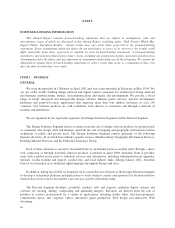Autodesk 2002 Annual Report Download - page 21
Download and view the complete annual report
Please find page 21 of the 2002 Autodesk annual report below. You can navigate through the pages in the report by either clicking on the pages listed below, or by using the keyword search tool below to find specific information within the annual report.Allowance for Bad Debts. We maintain allowances for doubtful accounts for estimated losses resulting
from the inability of our customers to make required payments. No single customer is significant to Autodesk,
and as such, our exposure to uncollectible trade receivables is generally limited.
Estimated reserves are determined based upon historical loss patterns, the number of days that billings are
past due and an evaluation of the potential risk of loss associated with specific problem accounts. While we
believe our existing reserve for doubtful accounts is adequate and proper, additional reserves may be required
should the financial condition of our customers deteriorate or as unusual circumstances arise.
Product Return Reserves. With the exception of contracts with certain distributors, our sales contracts do
not contain specific product-return privileges. However, we permit our distributors and resellers to return product
in certain instances, generally when new product releases supercede older versions.
Over the past three years, product returns as a percentage of revenues have ranged from 3 to 5 percent
annually. The product return reserves are based on estimated channel inventory levels and the timing of new
product introductions and other factors. While we believe our accounting practice for establishing and
monitoring product returns reserves is proper, any adverse activity or unusual circumstances could result in an
increase in reserve levels in the period in which such determinations are made.
Realizability of Long-Lived Assets. We review the realizability of our long-lived assets and related
intangible assets annually or sooner whenever events or changes in circumstances indicate the carrying values of
such assets may not be recoverable. We consider some of the following factors important in deciding when to
perform an impairment review: significant under-performance of a business or product line relative to budget;
shifts in business strategies, which impact the continued uses of the assets; significant negative industry or
economic trends; and the results of past impairment reviews.
In assessing the recoverability of these long-lived assets, we first determine their fair values, which are
based on assumptions regarding the estimated future undiscounted cash flows that could reasonably be generated
by these assets. Impairment charges, if any, result in situations when the fair values of these assets are less than
their carrying values. During fiscal 2002, we recognized a goodwill impairment charge of $2.3 million. The
write-off of goodwill primarily related to an acquired GIS business and resulted from a strategic decision to
abandon the underlying product line.
We will continue to evaluate the values of our long-lived assets in accordance with applicable accounting
rules. As changes in business conditions and our assumptions occur, we may be required to record impairment
charges.
Deferred Tax Assets. We currently have $60.9 million of deferred tax assets, mostly arising from net
operating losses, reserves and timing differences for purchased technologies and capitalized software. We
perform a quarterly assessment of the recoverability of these deferred tax assets, which is principally dependent
upon our achievement of projected future taxable income in specific geographies. Our judgments regarding
future profitability may change due to future market conditions and other factors. These changes, if any, may
require possible material adjustments to these deferred tax assets, resulting in a reduction in net income in the
period when such determinations are made.
Restructuring Expenses Associated with Office Closures. During the year ended January 31, 2002, we
recorded restructuring charges of $19.2 million related to the closure of several domestic and international
offices. These charges were based upon the projected rental payments through the remaining terms of the
underlying operating leases, offset by projected subleasing income. The projected subleasing income amounts
were provided by third-party real estate brokers and were based on assumptions for each of the real estate
markets where the leased offices were located. Should real estate markets worsen and we are not able to sublease
the properties as expected, we will record additional expenses in the quarterly period when such determinations
20
























